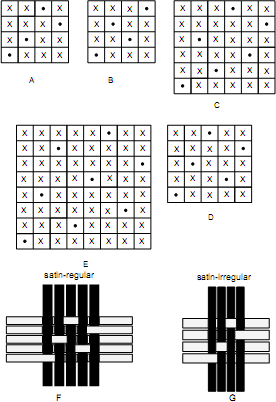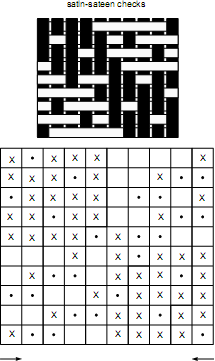Re-Arranged Twills
These twills are obtained by arrangement of a continuous twill either warp way or weft way. There arrangement is normally done in a particular order or sequence. Rearranged twills are of two types Satin/sateen weaves and Corkscrew weaves.
Rearranged Twills
These twills are obtained by the arrangement of a continuous twill either warp way or weft way. The rearrangement is normally done in a particular order or sequence. Rearranged twills are of two types:
- Satin/sateen weaves
- Corkscrew weaves
Satin and Sateen Weaves

Satin is a warp-faced rearranged twill and sateen is a rearranged weft faced twill. Thus satin is the reverse side of sateen weaves. These weaves form an important category of weaves. They are used in combination with other weaves, particularly in case of ornamented fabrics. The striking feature of these weaves is their bright appearance and smooth feel. The basic characteristic of satin/sateen weaves are:
- They are either warp or weft-faced weaves.
- Have no prominent weave structures
- Only one binding point in each end or pick
- No continuous twill lines
- Have poor seam strength due to thread mobility
- More thread density is possible in warp and weft
- More mass per unit area is possible
- Have less binding points and more float lengths
- Use of move numbers (intervals of selection) is necessary to construct these weaves.
In the construction of satin/sateen weaves, the stitching points of warp or weft for a given repeat size is done by the use of move numbers or stitch or float numbers. The move numbers are selected according to the repeat size of the weave. In choosing move numbers for the construction of satin/sateen weaves, the following rules are to be adopted:
- The move number should not be equal to the repeat of the weave
- It should not be one less than the repeat size
- It should not be a factor of the repeat size, and
- It should not be a multiple of the factor.

In the figure, B and C show the design of irregular sateen weaves and D and E show regular sateen design. A shows a 4 end irregular sateen constructed with the step number of 1 and B shows the same design using the step number f 2. C shows a 6 end irregular sateen. D and E show the designs of a regular 5 end and 8 end sateen constructed with step number of 3. F and G show the interlacings of design D and A respectively.
The following table shows the intervals of selection for the construction of satin weaves on five, and seven to twenty-two threads. Instead of the numbers given, their reciprocals may be taken. Where two intervals are given, each of these or their reciprocals will produce similar results. Where more than two intervals are given, the number of numbers shown in heavy type (or their reciprocals) will give the perfect distribution of intersections.
| Type of Satin | Suitable move number |
|---|---|
| 5 end | 2 |
| 7 end | 2,3 |
| 8 end | 3 |
| 9 end | 2,4 |
| 10 end | 3 |
| 11 end | 2,3,4,5 |
| 12 end | 5 |
| 13 end | 2,3,4,5,6 |
| 14 end | 3,5 |
| 15 end | 2,4,7 |
Stripe and Check effect on Satin-Sateen Weaves


End use of Satin-Sateen Weaves
Satin weaves find a wide range of application such as denim, interlining cloth, ribbons, dress materials (lustrous), children’s dress materials etc.


